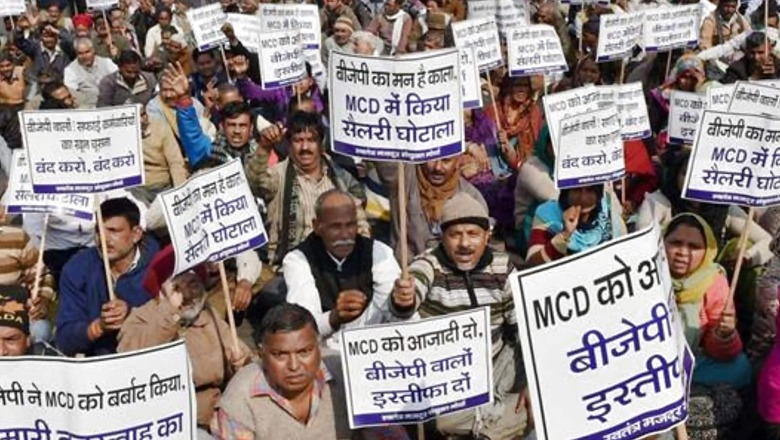
views
The Municipal Corporation of Delhi (MCD) was envisaged by policy-makers around a decade after India’s independence and began its journey in April 1958 with 80 councillors, according to archival records.
As per old documents and reports accessed by PTI, and views of many experts, the MCD was modelled on the lines of the ‘Bombay Municipal Corporation’, and was set up after amalgamating several local bodies and administrative committees.
The erstwhile unified MCD was then trifurcated in 2011 and three new civic bodies came into being in 2012 — North Delhi Municipal Corporation (NDMC), South Delhi Municipal Corporation (SDMC) and East Delhi Municipal Corporation (EDMC), which were unified into a single civic entity again in May 2022.
A fresh delimitation exercise was conducted after the Union Ministry of Home Affairs in July had set up a three-member panel for redrawing of the municipal wards in Delhi.
The central government then fixed the total number of seats in the MCD at 250 from the previous figure of 272.
Civic polls for the 250 wards are due on December 4 and it is the first municipal election in Delhi after the fresh delimitation of wards.
The election is largely being seen as three-way contest among the AAP, BJP and Congress. The BJP has been in power in the civic body since 2007 when the MCD was a unified body. The Municipal Corporation of Delhi had come into being under the Delhi Municipal Corporation Act, 1957.
According to archival records, there were 80 councillors in 1957, and through successive delimitation, the number of wards was expanded to 134 and eventually to 272 in 2007. After trifurcation, the NDMC and SDMC had 104 wards each while the EDMC had 64, till the three civic bodies were unified into MCD early this year.
As per the wordings of the DMC Act 1957, “Municipal Government of Delhi was being administered as per the provisions of the Punjab District Boards Act, 1883 (2 of 1883) and the Punjab Municipal Act, 1911 (3 of 1911)”.
To run the municipal affairs of Delhi, there were various bodies and local authorities, including Municipal Committee, Delhi; Notified Area Committee, Civil Station; Notified Area Committee, Red Fort; Municipal Committee, Delhi-Shahdara; Municipal Committee, West Delhi;Municipal Committee, South Delhi; Notified Area Committee, Mehrauli; Notified Area Committee, Najafgarh; and Notified Area Committee, Narela, it said.
Other local bodies were District Board, Delhi; Delhi State Electricity Board; Delhi Road Transport Authority; and Delhi Joint Water and Sewage Board, the Act said.
“With so many bodies and local authorities looking after the municipal affairs, complications and problems were being faced by the various authorities as well as by the public. A need to have a unified body to administer the Municipal Government of Delhi was strongly felt. Accordingly to consolidate and amend the laws relating to the Municipal Government of Delhi, the Delhi Municipal Corporation Bill was introduced in the Parliament,” it said.
The Delhi Municipal Corporation Bill having been passed by both the Houses of the Parliament was assented by the President on December 28, 1957.
The MCD thus came into being in 1958 when the Delhi got its first mayor, evolving out of the municipal administration system that began around 1860s. The headquarters of the newly-formed civic body was at the historic Town Hall, a nearly 160-year-old iconic building in Chandni Chowk area, in which the earlier Delhi municipality was also housed, and where the MCD remained till late 2000s, before moving base to the swanky 28-storey-high Civic Centre in front of the New Delhi railway station.
Lutyen’s Delhi area governed by the New Delhi Municipal Committee (later New Delhi Municipal Council) and Delhi Cantonment areas were kept out of the ambit of the new corporation.
As Delhi now has a unified municipal corporation and will soon get a mayor for the whole city again after a gap of 10 years, many Constitutional experts have recalled the inception and journey of the erstwhile MCD which they said was a “very powerful body” with a “very powerful mayor”.
Old documents and archival reports, pertaining to the period when the MCD was being conceptualised after merging a number of existing local bodies, mention that it was modelled after the Bombay Municipal Corporation or BMC (now Brihanmumbai Municipal Corporation) that was set up by the British in the second half of the 19th century to administer the then Bombay Presidency.
Early this year, soon after the proposed re-unification of three corporations, former Delhi chief secretary and ex-state election commissioner Rakesh Mehta had said, “The MCD already has the infrastructure, the Civic Centre has a House to accommodate all the councillors in one place, and mayor too will have a greater stature by virtue of being the first citizen of the city, as it was pre-trifurcation”.
“In unified era of the MCD, the mayor was the number one citizen of Delhi and a mayor received foreign dignitaries at airport and accorded civic receptions at Red Fort or Ramlila Maidan,” a senior official said.
Delhi Transport Undertaking (later Delhi Transport Corporation), Delhi water board and some of the other units were also under the erstwhile MCD earlier.
Read all the Latest Politics News here
















Comments
0 comment